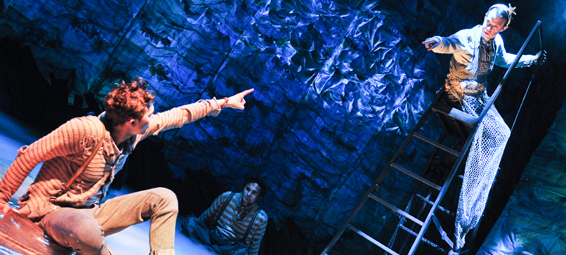At the beginning of Peter and the Starcatcher, the cast asks its audience to “use your thoughts to hoist the sales.” Assembled on a stripped-down stage and lit starkly by footlights, the group calls to mind an old-fashioned troupe of traveling performers. The stage concept of this Peter Pan prequel was influenced by the renowned 1981 production of The Life and Adventures of Nicholas Nickleby, where the cast—out of necessity—assumed various roles and stepped in and out of the action to narrate the mammoth story. For Peter, it’s an idea both brilliant and obvious, simple and intricate, and one that heavily utilizes the most powerful tool: our own imagination.
Though thankfully not eight hours long like Nickleby, Peter is nonetheless an epic tale. Rick Elice (of Jersey Boys fame) adapted the children’s adventure novel by Dave Barry and Ridley Pearson, and the story includes raging sea battles, ruthless pirates, a desert island, massive crocodiles, bloodthirsty natives, flying cats, and a magical substance called “starstuff.” It also subtly lays the groundwork for the Peter Pan we know from J.M. Barrie’s novel, though here there is a plucky girl named Molly (Megan Stern) and the lead pirate is called Black Stache.
Let’s talk about that scurrilous scallywag. It wouldn’t have been out of line for the play to be titled Black Stache and the Devoured Scenery instead, since the character is the most fascinating element in a piece that’s already bursting with charm. John Sanders, who played Stache and several other roles during the show’s Broadway run, is a wild hoot with flawless comic timing. A bit of drawn-out physical comedy in the second act even wins applause that’s on par with a diva’s signature wail.
If Stache’s modern-day lingo seems anachronistically clumsy at times (“ermahgerd” makes it in there), point to directors Roger Rees and Alex Timbers (who also helmed the historically confused Bloody Bloody Andrew Jackson). Their deliberate mixing of proper comedy with low humor allows the play to feel less stuffy than its 1880s setting might dictate while creating an irrepressible atmosphere of childish naughtiness. Fart jokes: funny for all ages.
A different sort of juvenile mentality is used to stupendous effect in the show’s design, in the sense that we are provided with artfully chosen clues and then encouraged to let our minds sketch in the rest. The team—set, lighting, costumes, and sound—swept the Tony Awards with their unobtrusive yet whimsical choices, which create magical worlds and creatures using seemingly little more than found objects, a sturdy length of rope, and at times even the cast’s own bodies. The message here? Instruments for imagination are always close at hand, and child-like wonder never has to fade. Maybe we don’t have to grow up after all.





